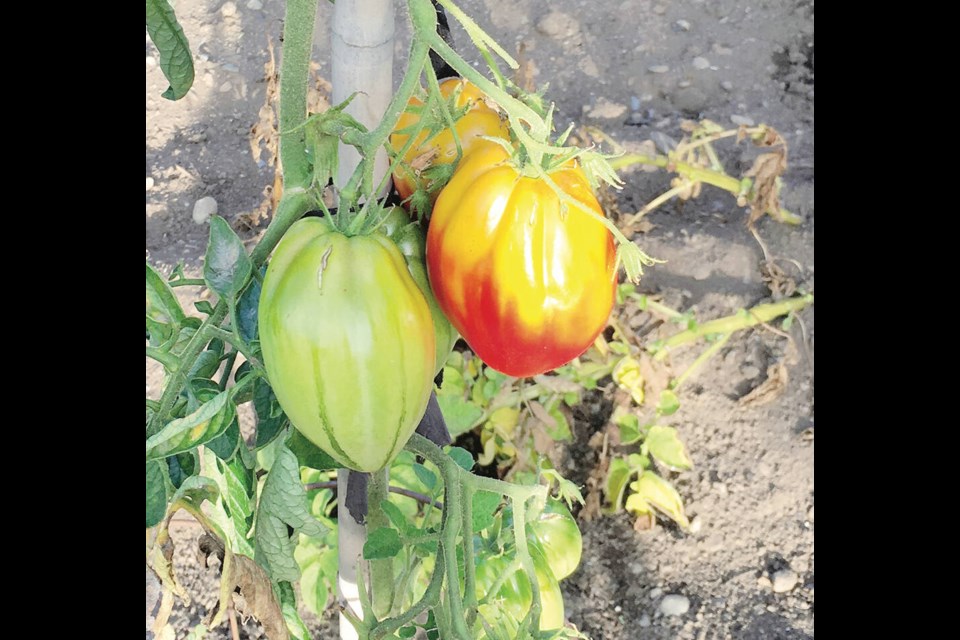Dear Helen: As the cherry tomatoes on my deck ripen, the bottom part of the fruits turns red while the upper part remains whitish yellow. Is this a disease?
K.G.
What you describe is not a disease but a physiological condition called sunscald, caused by direct, hot sun. The lower area of the fruit is protected and ripens normally while the upper, exposed part is affected by direct, hot sun. Tomato leaves will also often display whitish blotches from sunscald.
Plants with enough foliage to provide a leafy cover over ripening tomatoes offer protection against sunscald. If the pots are easily moveable, find locations for them where they are protected from the hottest afternoon sun. Tomatoes growing in the garden can be protected with a lightweight cover of shade cloth, fine screening or old lace curtains during very hot, sunny weather.
Dear Helen: I was disappointed when the first, most eagerly anticipated cucumber from the garden this summer was bitter. What might have caused this?
A.D.
Any kind of stress to the plants can cause bitterness in cucumbers. Most often, especially in our recent hot, dry summers, that stress is commonly inadequate or inconsistent supplies of moisture to the plants. Physical damage to plants can contribute to bitterness as well. For clean, nicely shaped and sweet-tasting cucumbers grow them vertically on a support.
Some varieties are more prone than others to bitterness. Try a few different varieties each year until you find ones that grow best and produce the most pleasing flavours in your garden conditions.
I should add that the first cucumber I cut from my vines this summer was bitter. Since then, all the cucumbers I’ve gathered have been sweet and tasty. I think I was too keen to have that first cucumber and pounced on the most likely looking one before it had reached optimal ripeness.
Dear Helen: Gardening friends and I are wondering why the cabbage, broccoli and cauliflower we grow are sometimes infected by clubroot while the kale has never been affected by the same disease. They are all closely related plants. Can you explain?
K.L.
I have observed a similar incidence of clubroot in my garden. Kale does seem less susceptible to this parasitic micro-organism that attacks the roots, causing distortions and swelling. Plants are weakened and usually become unproductive.
The only explanation I’ve ever heard for its immunity to clubroot is that kale is a more ancient, primitive brassica. The others are more recently developed and more highly bred. Having said that, I have had a kale planting afflicted with the disease, but just once, over many years of gardening.
Gardens with clubroot in the soil can still grow cabbage family vegetables by leaving as many years as possible between these plantings in any given part of the garden and by liming generously before planting. The clubroot organism is suppressed in soils with a pH of 7.2 or higher. Cool soils also lessen the degree of infection. Plant as early as possible, and use soil-cooling mulches in summer.
Dear Helen: Can you explain the white segments on my blackberries?
J.C.
Blackberries and raspberries are composed of segments called drupes. Each one is called a drupelet. Hot, dry, sunny conditions can cause a sunscald known as “white drupelet disorder” in the berries. Individual drupelets are tan or white. Hot, drying winds can also contribute to the conditions, together with full exposure to hot afternoon sun.
GARDEN EVENTS
Dahlia meeting. The Victoria Dahlia Society will meet at 7 p.m. on Thursday, Aug. 3, at 5021 Santa Clara Ave. Members will go over preparations for the society’s annual Dahlia Show on Aug. 19 and 20. Growers Teresa Thom and Barry Willoughby will show the group the best way of transporting dahlias and arranging them. A Q&A session will follow. Visitors are welcome.
Plant sale. The Victoria Compost Education Centre is hosting their annual August Plant Sale on Saturday, Aug. 12, from 10 a.m. to 2 p.m. in Haegert Park, 1202 Yukon St, one block from the Centre’s site on North Park St. Local farmers will be offering a wide variety of organically grown overwintering vegetables and perennials. The event will also feature music, a raffle, artisan vendors, a parent-child “Garden Arts & Crafts workshop, and an opportunity to learn about composting. Entry by donation. Funds raised support CED educational programming.



